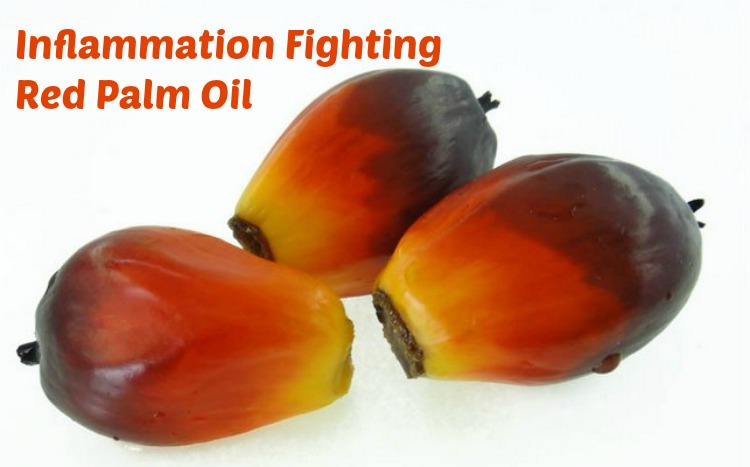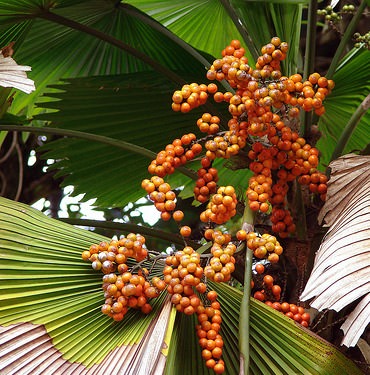 When it comes to tropical oils, coconut gets all of the attention.
When it comes to tropical oils, coconut gets all of the attention.
Smooth and slightly sweet, coconut oil has become the glamorous starlet of the health food industry in recent years. It is fame rightfully won. With metabolism-boosting medium chain fatty acids and an impressive trace mineral content, there is no denying that coconut oil is highly beneficial.
Yet there is another all-too-often ignored tropical oil that has shown tremendous promise in fighting inflammation, quelling disease, and stabilizing appetite. If you are allergic to coconut or coconut oil, this is especially good news!
This rivaling fat is none other than the colorful and nutrient-dense red palm oil.
What is Red Palm Oil?
Red palm oil is a traditional fat that is derived from the fruit of the Elaesis guineensis or oil palm tree native to tropical Africa. This vibrantly tinted oil has been harvested by local peoples for centuries and used for a dynamic range of culinary, cosmetic and medicinal applications. With a history that is believed to date back as far as 5,000 years, archeologists have even identified palm oil residue in earthenware jars from the tombs of esteemed Egyptian Pharaohs, suggesting its sweeping importance across the ages.
The expansion of international trading practices throughout the 16th century allowed the once geographically isolated palm oil to be introduced to new parts of the world, including South America and Southeast Asia. From this global dispersal onwards, palm oil has gained popularity in many nations as people recognize the nutritional prowess and versatility of this valuable commodity.
In many countries, palm oil is highly coveted for its nutrient stability, long shelf life, high smoke point, unique flavor and the luscious quality it lends to grilled foods and baked goods. According to tropical oil expert Dr. Bruce Fife, palm oil has even recently surpassed soybean oil as the most widely used oil in the world.
Red Palm Oil Benefits
Science has confirmed the benefits that our ancestors intuitively knew about red palm oil. Analyses have revealed an impressive nutrient profile, and clinical studies have demonstrated its many advantages for modern health.
 One study showed that palm oil halted atherosclerosis in patients with heart disease, while other researchers have suggested that certain components in red palm oil are strong anti-cancer agents. Put simply, red palm oil is brimming with so many nutrients and antioxidants it’s more like a natural dietary supplement than anything else.
One study showed that palm oil halted atherosclerosis in patients with heart disease, while other researchers have suggested that certain components in red palm oil are strong anti-cancer agents. Put simply, red palm oil is brimming with so many nutrients and antioxidants it’s more like a natural dietary supplement than anything else.
In fact, some companies are now encapsulating it to be sold in vitamin shops and health food stores. The oil is also available in jars and bottles like other vegetable oils for regular kitchen use.
7 BIG Health Benefits
Few healthy fats offer this many benefits to human health!
- Rich with medium chain fatty acids
- Full of antioxidant Carotenoids (beta-carotene and lycopene)
- Contains naturally occurring Vitamin-E (tocopherols and tocotrienols)
- One of the richest plant sources of heart-protective CoQ10
- High levels of immune-strengthening squalene
- Easily digested and stable for high heat cooking
- Inflammation-reducing plant sterols
Traditional Red Palm Oil Harvesting
Despite a deep history and impressive nutrient profile, we tend to hear very little about palm oil from media sources in the United States. This devastating omission has been caused in part by the wrongful demonization of saturated fat that duped our nation from the mid-20th century and onwards. However, poor production practices by greedy palm oil industry leaders have also cast a negative shadow on this otherwise remarkable oil.
The traditional production of palm oil is artisanal in quality. Palm fruit is carefully inspected and picked by hand to select for only the best quality specimens. Once picked, the fruit is left for a full 36 hours to soften, then plucked, washed, and steamed for only a few minutes to further break down the pulp. Next, the fruit is poured into a large mortar and pounded until the flesh separates from the nut. The nut is set aside to dry.
At this time, the brilliant oil of the palm fruit begins to appear. To remove any excess water, the red oil is heated slightly and then sits for 24 hours to allow for all impurities to be removed and sink to the bottom of the tank. To ensure that no additional impurities are intact, the red oil is filtered through a slowly working gravity system to leave only the most wholesome and nutrient-rich oil.
Unsustainable Modern Palm Oil Processing
Unfortunately, the production of many modern palm oils is in stark contrast to this slow and careful process. Different varieties of palm oil have cropped up in recent years, including those derived from the kernel instead of the accustomed fruit and others that are purified to remove the characteristic red color (and with it the antioxidant pigments it contains.)
Commercial palm oil is often harshly and rapidly extracted using questionable chemical solvents, then further refined and deodorized. This process is very similar to the processing of canola oil. Although convenient for output and profit-focused companies, these practices deplete nutrients and compromise the integrity of the oil. Some palm oil is even used as a base for hydrogenation, completely ruining the beautiful, healthy fat.
Additional controversy and stigmatization have been created by sustainability concerns with large-scale palm oil production efforts. Certain palm oils, primarily those from industrial suppliers in Malaysia & Indonesia, are irresponsibly harvested in a way that threatens orangutan habitats and disregards local culture.
To address these issues and to protect the cultural significance of red palm oil extraction, an organization known as the RSPO (Roundtable on Sustainable Palm Oil) was formed. RSPO certification verifies that palm oils are harvested in a manner that protects wildlife as according to the standards of the World Wildlife Fund (WWF) and also maintains the integrity of the local communities from which the red palm oil is acquired.
Take a Stand for Sustainable Red Palm Oil
As consumers, we have the opportunity to protect precious red palm oil in its natural form by sourcing red palm oils that are RSPO certified and traditionally made, such as this quality brand of sustainable red palm oil.
By seeking out companies that work with local communities to bring sustainable and pure red palm oil into our kitchens and homes, we are not only able to experience the many health benefits that red palm oil has to offer, but are also preserving the art of a cherished traditional food so that it too can be passed on for generations to come.
Sources and More Information
The Palm Oil Miracle by Bruce Fife, ND
Five Fats You Must Have in Your Kitchen
The Truth About Pumpkin Seed Oil
Selecting a Healthy Cooking Oil and Reusing it Safely
Caution When Using Chicken Fat for Cooking
Cooking with Olive Oil: Yea or Nay?
How Vegetable Oils Make Us Fat
How Argan Oil Benefits Health
Is Rice Bran Oil a Healthy Fat?
Walnut Oil: Healthy Sub for Flax Oil








Leave a Reply